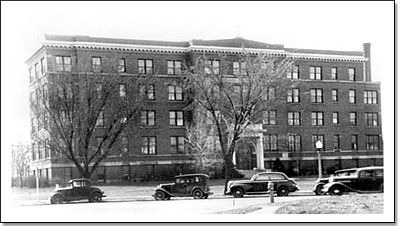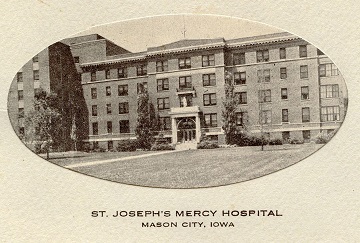


Cerro Gordo County Iowa
Part of the IAGenWeb Project
|
and Sisters of Mercy 1000 4th Street, Mason City Mason Township, Cerro Gordo County, Iowa

Since 1827, people have turned to Mercy for health care. Catherine McAULEY opened the first House of Mercy in Dublin, Ireland, where people in need were offered shelter, education, and health care. Catherine McAULEY, a cultured young woman of an old and distinguished family who, possessed of a large fortune and impelled by the distress and need of the poor of her native country, decided to devote this entire fortune to the relief and care of orphans, destitute women and poor schools. The first building erected for this cause was dedicated September 24, 1827. Soon many young women joined Miss McAULEY to assist in her noble work, that in a few short years her house was changed from a secular to a religious institution. On December 12, 1831, the new institute was confirmed as the Congregation of the Sisters of Mercy. Following this mark of stability, members rapidly increased, similar institutions multiplied, not only in Ireland, but expanded in less than fifteen years to England and the United States.
The first foundation of the Sisters of Mercy in the United States was made at Pittsburgh, in 1843, through the appeal made by the Rt. Rev. M. O'CONNOR to the Sisters while visiting at their convent in Carlow, Ireland. He explained the great need for carrying out the works of mercy in his diocese of Pittsburgh, and in response to this appeal seven Sisters volunteered to return with him. It is recorded in the annals of the Order that when they arrived in New York, the first person to meet them was the Rt. Rev. William QUARTER, bishop-elect of Chicago. He, too, needed Sisters to work in the far West, but the most he could obtain at that time was a promise that the Sisters would come as soon as possible, which promise was fulfilled when five Sisters arrived in Chicago, in 1846. This was the beginning of St. Xavier's, Chicago. Civil War Volunteers: Although the Chicago community was only in its early development at the outbreak of the Civil war, yet the patriotic zeal of its constituents enabled it to spare eight members to serve their country's cause by ministering to the sick and wounded. It is of interest to note that two of this band of nurses were Mother Mary Borromeo JOHNSON and Mother Mary Francis MONHOLLAND, who later came as charity workers to Iowa. The annals record that in September, 1861, these eight Sisters left Chicago in company with the military officer who had been sent to conduct them. They set out by way of St. Louis for Lexington, Missouri, a place they failed to reach. After many delays and thrilling incidents they arrived at Jefferson City. Immediately on their arrival they were requested to take charge of the City Hospital, which was crowded with sick and wounded soldiers. They remained there until April, 1862, when, the division being ordered elsewhere, their services were no longer needed. At Saint Louis, on their way home, they were met by a sanitary commissioner who asked them to take charge of the hospital department on the steamboat Empress, which was carrying wounded soldiers from the battlefield of Shiloh. One one of its trips up the Mississippi the Empress reached Keokuk, Iowa, April 16, 1862. It required two days to remove the sick and wounded soldiers to the hospital. The Sisters did everything possible to relieve the suffering of their patients during the five weeks they spent on their floating hospital. Sisters of Mercy come to Iowa: Following the close of the Civil war, in 1867 Mother Mary Borromeo JOHNSON and four Sister companions from Saint Xavier Academy, Chicago, opened a school in the little town of DeWitt. Shortly afterwards doctors from Davenport asked for Sisters to open a hospital. In response to this invitation Mercy Hospital was opened in 1868. In 1869 a school and academy were opened in Independence by Mother Mary Francis MONHOLLAND and her cultured and experienced Sisters. Davenport having the most desirable location, Mercy Hospital was made the first Motherhouse of the Sisters of Mercy in Iowa, and Mother Mary Borromeo JOHNSON was chosen Mother Superior. From this house as a center, all the other houses in Iowa, with one exception, [Council Bluffs], have been either directly or indirectly founded. Development in Iowa: Mercy Hospital, Davenport, filled an urgent need in the pioneer community and its growth was rapid. From the first day to the present the work has gone ahead; addition after addition has been erected. . . . Today [1931] Mercy Hospital, together with its departments for nervous and mentally afflicted men and women, ranks s one of the best equipped institutions in the country. From this institution foundations have been sent to Iowa City, Cedar Rapids, Dubuque, Des Moines, and Marshalltown. In later years the labors of the Davenport Sisters of Mercy have been extended to a Young Women's Home in Davenport and schools in Davenport, Burlington, West Burlington, Mount Pleasant, Manilla and Rockwell City.
Besides institutions conducted in Dubuque by the Sisters of Mercy, they have hospitals in Sioux City, Clinton,
Mason City, Fort Dodge, Waverly and Cresco; schools at Eagle Center, Bankston, Ackley and Independence.
In the late 1800s, the Sisters of Mercy opened hospitals in rural towns and cities across the state of Iowa. The sisters were determined to carry out their mission - caring for persons in need. They worked closely with physicians, nurses, and other individuals who shared the belief that all people in the community deserve good care, given in a compassionate, respectful manner. The Sisters of Mercy opened St. Joseph Mercy Hospital in Mason City in 1916. Their efforts to care for the growing community augmented those of a group of local doctors, who had established Park Hospital seven years earlier. Park later was renamed North Iowa Medical Center and was moved from its downtown location to the west side, 901 North Eisenhower Avenue. To enhance service delivery and address issues relating to rising costs, the hospitals consolidated in 1993 as North Iowa Mercy Health Center. Known today as Mercy Medical Center - North Iowa, the Medical Center has taken a prominent role in ensuring that patients across northern Iowa and southern Minnesota have access to and receive exceptional quality health care and experience world-class service.
Click on "back button" to return to this webpage.
 Park Hospital

SOURCES:
|
© Copyright 1996-
Cerro Gordo Co. IAGenWeb Project
All rights Reserved.